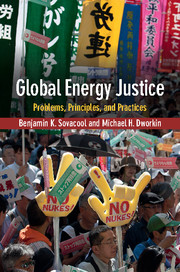Book contents
- Frontmatter
- Epigraph
- Dedication
- Contents
- Analytical table of contents
- List of figures
- List of tables
- Acknowledgements
- List of abbreviations
- 1 Introduction
- 2 The global energy system
- 3 Virtue and energy efficiency
- 4 Utility and energy externalities
- 5 Energy and human rights
- 6 Energy and due process
- 7 Energy poverty, access, and welfare
- 8 Energy subsidies and freedom
- 9 Energy resources and future generations
- 10 Fairness, responsibility, and climate change
- 11 The imperative of making just energy decisions
- Index
- References
2 - The global energy system
Published online by Cambridge University Press: 05 October 2014
- Frontmatter
- Epigraph
- Dedication
- Contents
- Analytical table of contents
- List of figures
- List of tables
- Acknowledgements
- List of abbreviations
- 1 Introduction
- 2 The global energy system
- 3 Virtue and energy efficiency
- 4 Utility and energy externalities
- 5 Energy and human rights
- 6 Energy and due process
- 7 Energy poverty, access, and welfare
- 8 Energy subsidies and freedom
- 9 Energy resources and future generations
- 10 Fairness, responsibility, and climate change
- 11 The imperative of making just energy decisions
- Index
- References
Summary
Introduction
Joan Brown, a college student in Atlanta, Georgia, wakes up in the morning to an electronic alarm clock before she microwaves breakfast, takes a hot shower, grabs a latte at Starbucks, and drives her Sport Utility Vehicle to campus – where she texts her boyfriend during class and checks email on her iPad. Gertrude Smith, a widowed grandmother living in London, the United Kingdom, drinks watered down milk for breakfast (to make the carton last longer), walks everywhere, uses discarded newspapers as makeshift lampshades, and reuses her bathwater to clean dishes and clothes. She pays her energy bills with jars of coins. Tiemoko Sangare, a farmer in Tanzania, spends half of his day searching for wood and water and the other half cultivating crops by hand. He has never had a hot shower or bath, and rises and rests according to the sun, with no indoor lighting at night. Sometimes, if his yields are good, he can afford to purchase charcoal at the local market near Dar es Salaam.
These examples show that we are in the midst of a transformational shift in the use of energy – with some, like Ms. Brown, adopting very energy-intensive living. Modern forms of energy have also become key to industrialized lifestyles across the globe, with the late German parliamentarian Hermann Scheer once remarking that energy and raw materials are the “nervus rerum,” the “nerve of all things,” for our economies. However, these examples also reveal that the global energy system – the backbone of modern lifestyles and economic development – reflects and perpetuates vast inequities and inequalities. For some of us, lack of access to energy services is a mere inconvenience; for others, such as Mr. Sangare, it is a matter of life or death. Some of us consume staggering amounts of liquid fuels and electricity – and have significantly large carbon footprints – while others go completely without modern energy services and contribute almost nothing to climate change.
- Type
- Chapter
- Information
- Global Energy JusticeProblems, Principles, and Practices, pp. 31 - 87Publisher: Cambridge University PressPrint publication year: 2014



